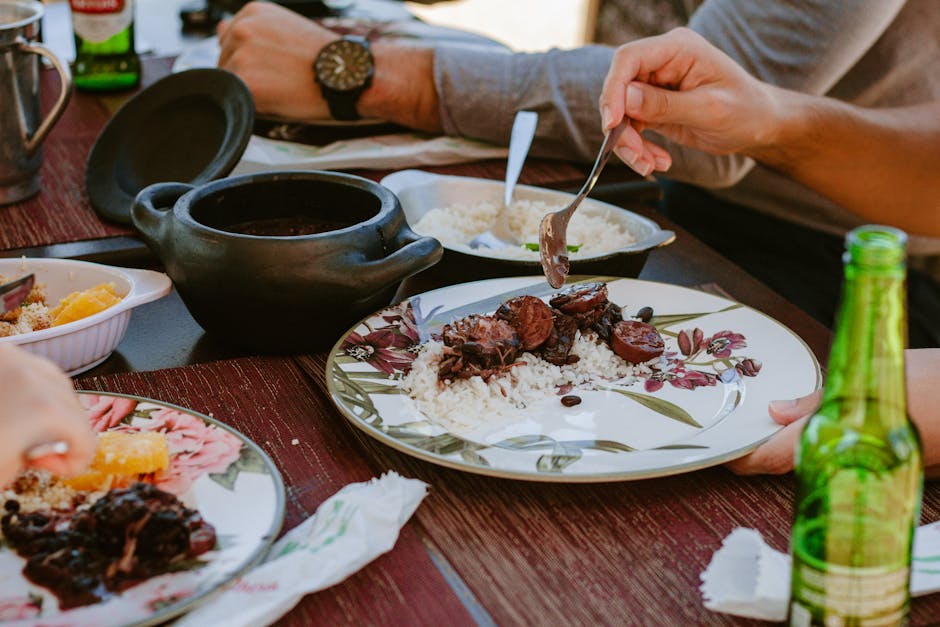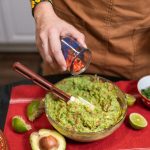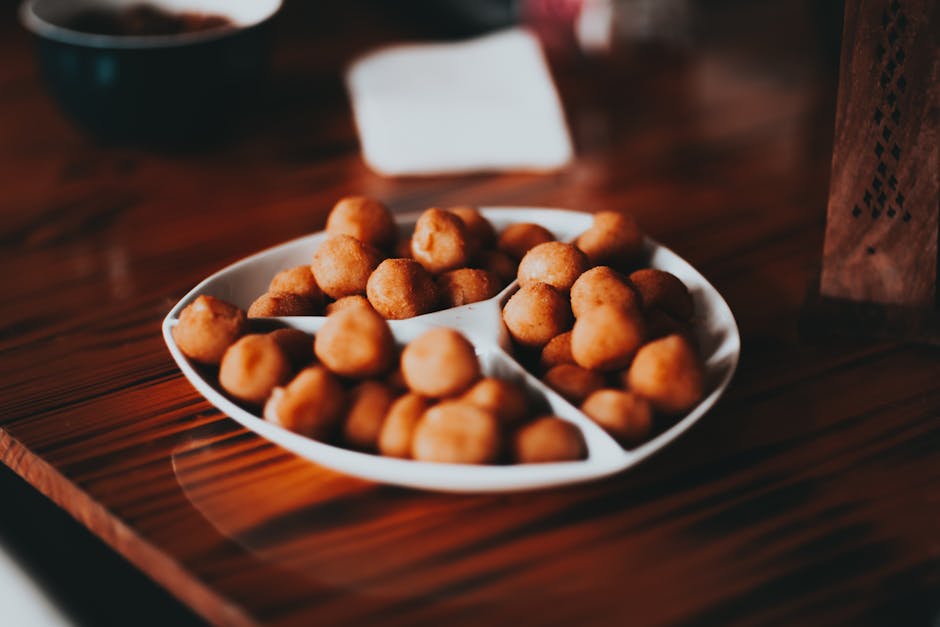Prepare yourself for a culinary journey to Brazil with a dish as rich and complex as its history: Homemade Brazilian Feijoada. This isn’t just a meal; it’s an experience, a testament to Brazilian culinary heritage, and a celebration of its diverse cultural influences. Feijoada, a hearty black bean stew, is arguably Brazil’s national dish, a symbol of national pride and a staple enjoyed across the country, from bustling city centers to remote rural communities.
Its origins are shrouded in some mystery, but most historians trace Feijoada’s roots back to Portugal, specifically to the 16th and 17th centuries, during the height of Brazilian colonization. Early versions likely incorporated readily available ingredients like black beans and various cuts of pork, reflecting the resourcefulness of the time. However, the dish evolved significantly in Brazil, absorbing influences from indigenous and African cultures. The addition of smoked meats, sausages, and spices reflects the syncretism of Brazilian cuisine, a beautiful blend of diverse culinary traditions that shaped the nation’s identity.
Over the centuries, Feijoada became more than just food; it became a social and cultural phenomenon. Saturday lunches are traditionally reserved for enjoying Feijoada with family and friends, often accompanied by farofa (toasted cassava flour), rice, collard greens, and orange slices to cut through the richness. It’s a communal experience, a time for sharing stories and strengthening bonds. In fact, it’s estimated that over 80% of Brazilians consume Feijoada at least once a year, highlighting its enduring popularity and cultural significance. This statistic underscores its importance not just as a dish but as a symbol of Brazilian identity and national unity.
Beyond its widespread popularity, Feijoada holds a special place in Brazilian culture, often associated with celebrations and festivities. Variations of the recipe exist throughout the country, reflecting regional differences in ingredients and preparation methods. Some versions might include beef or even chicken, while others might feature specific types of sausages unique to a particular region. This diversity within the dish itself mirrors the rich tapestry of Brazilian culture, showcasing the myriad of influences that have shaped its culinary landscape. So, get ready to savor not just a meal, but a piece of Brazilian history and culture with this authentic homemade Feijoada.
Ingredients and Measurements
Crafting an authentic Brazilian Feijoada requires careful attention to the ingredients and their proportions. The richness and depth of flavour come from using high-quality ingredients and allowing ample time for the slow simmering process. Below is a detailed list of ingredients and their measurements for a generous serving of 6-8 people. Feel free to adjust the quantities based on your needs, but maintain the relative ratios for optimal flavour.
Black Beans (Feijão Preto): 1.5 lbs (680g) dried black beans. It’s crucial to use dried black beans for the best texture and flavour. Soaked overnight in plenty of water (at least 8 cups), this softens them and reduces cooking time. Discard the soaking water before cooking. If using canned beans, you’ll need approximately 3 (15-ounce) cans, but the flavour will be less intense.
Pork: This is where the heart of the Feijoada lies. We’ll use a combination for maximum flavour and texture: 1 lb (450g) smoked pork ribs (costela defumada), cut into 2-inch pieces; 1 lb (450g) pork shoulder (linguiça), cut into 1-inch cubes; and 1/2 lb (225g) cured pork sausage (chouriço), roughly chopped. Choosing high-quality pork is essential. Look for cuts with good marbling for richness and flavour. If you can’t find smoked ribs, you can use unsmoked ribs and add liquid smoke for a hint of smoky flavour.
Beef: While traditionally less prominent than pork, beef adds another layer of complexity. Use 1/2 lb (225g) beef chuck, cut into 1-inch cubes. Choose a cut with some fat for better flavour and tenderness during the long cooking process. This can be substituted with beef shank if preferred.
Aromatics and Seasoning: 2 large onions, roughly chopped; 4 cloves garlic, minced; 2 bay leaves; 1 tablespoon smoked paprika (paprica defumada); 1 teaspoon ground cumin; 1/2 teaspoon ground black pepper; 1/2 teaspoon dried oregano; 1/4 teaspoon cayenne pepper (optional, for a touch of heat); 2 cups (475ml) good quality beef broth; 1 cup (235ml) dry white wine (optional, but adds depth of flavour); 1 orange, zested and juiced (the zest adds a bright note while the juice helps tenderize the meat); 1 tablespoon olive oil.
Finishing Touches: Freshly chopped cilantro (coentro) for garnish; Orange wedges for serving; White rice (arroz branco) and farofa (toasted cassava flour) are traditional accompaniments. The garnishes are essential for the complete Feijoada experience. Don’t skip them!
Important Note: Adjust the amount of liquid (broth and wine) as needed during cooking. The Feijoada should have a rich, saucy consistency, but not be overly watery. Taste and adjust seasoning throughout the cooking process. It’s a journey, not a race. Allow ample time for the flavours to meld and the beans and meats to become tender.
Equipment List
Making a truly authentic and delicious Brazilian Feijoada requires the right equipment. While you can adapt some steps, having the proper tools will significantly enhance the cooking process and the final result. This list details the essential equipment, including alternatives where possible.
Large, Heavy-bottomed Stockpot (6-8 quart): This is the workhorse of your Feijoada operation. A heavy bottom is crucial for even heat distribution, preventing scorching and ensuring the beans cook evenly. A 6-8 quart pot is ideal for a standard batch, allowing plenty of room for the ingredients to simmer comfortably without overcrowding. Avoid using thin-walled pots as they are prone to burning and uneven cooking. Consider a pot made of stainless steel or enameled cast iron for optimal heat retention and durability.
Large Cutting Board: You’ll be chopping a significant amount of vegetables and meat, so a generously sized cutting board is essential. Choose a sturdy cutting board made of wood or high-quality plastic for easy cleaning and longevity. Avoid glass cutting boards, as they can dull knives quickly. A minimum size of 18 x 12 is recommended.
Sharp Chef’s Knife (8-10 inch): A sharp chef’s knife is indispensable for efficient and safe chopping of various ingredients. A dull knife will make the prep work tedious and potentially dangerous. Regular sharpening is crucial for maintaining the knife’s performance and safety. Consider investing in a honing steel to keep your knife sharp between sharpenings.
Meat Cleaver (Optional but Recommended): While not strictly necessary, a meat cleaver can be invaluable for breaking down larger cuts of meat, like the pork shoulder or beef shanks, into more manageable pieces for even cooking. If you are using pre-cut meats, a cleaver is less critical, but it will greatly speed up preparation for those starting with larger cuts.
Large Wooden Spoon or Spatula: You’ll need a sturdy utensil for stirring the Feijoada during the long simmering process. A wooden spoon is preferred as it won’t scratch your pot and is less likely to react with the food. Ensure it’s large enough to comfortably stir the contents of your pot.
Colander: A colander is essential for rinsing the beans before cooking and for draining off excess liquid if needed. Choose a colander that is large enough to hold all the beans comfortably. Stainless steel colanders are generally durable and easy to clean.
Measuring Cups and Spoons: Accurate measurements are key to achieving the desired flavor profile. Invest in a reliable set of measuring cups and spoons to ensure consistent results in your Feijoada.
Ladle: A ladle is helpful for serving the Feijoada and transferring it to bowls. Choose a ladle with a comfortable handle and a deep bowl to easily scoop up the beans and meat.
Serving Bowls: You’ll need serving bowls to present your delicious Feijoada. Consider bowls that are deep enough to hold the hearty stew and are visually appealing.
Timer: A timer is crucial for monitoring the cooking time, ensuring the beans are cooked through and the meat is tender. Use a kitchen timer or a timer app on your phone.
Preparation of the Meats
The success of a truly authentic Feijoada hinges heavily on the careful preparation of its meats. This involves selecting high-quality cuts and employing techniques that maximize flavor and tenderness. We’ll be using a combination of beef, pork, and smoked meats for a rich and complex taste profile. For this recipe, we’ll aim for approximately 2 pounds of meat in total.
Beef: Start with 1 pound of beef, ideally a combination of cuts. I recommend using ½ pound of beef chuck, which will provide a hearty, flavorful base, and ½ pound of beef shank. The shank, while initially tougher, will become incredibly tender after a long simmer. Trim away any excess fat, but don’t remove it all – a little fat adds depth of flavor. Cut both the chuck and shank into roughly 2-inch cubes. This ensures even cooking throughout the long braising process.
Pork: For the pork component, we’ll use 1 pound of pork shoulder (also known as Boston butt). This cut is known for its ability to become incredibly tender and flavorful when slow-cooked. Similar to the beef, cut the pork shoulder into 2-inch cubes. Again, trim away excess fat, but leave some for richness. Consider adding ½ pound of smoked sausage (chorizo or linguiça are excellent choices). Slice the sausage into ½-inch thick rounds. The smoky flavor will complement the other meats beautifully.
Optional additions: For an even more decadent Feijoada, feel free to incorporate other meats. A few spare ribs (about ½ pound) or even some smoked bacon (about 4 ounces) would add another layer of flavor and texture. Remember to adjust the overall meat quantity accordingly if you add these extra ingredients.
Pre-cooking (Optional but recommended): While not strictly necessary, pre-cooking the meats, particularly the beef, can enhance the flavor and ensure tenderness. Before adding the meats to the main Feijoada pot, you can brown them separately in batches in a large skillet over medium-high heat. This step helps to develop a rich, deep color and adds complexity to the final dish. Do not overcrowd the pan; work in batches to ensure proper browning. Once browned, set the meats aside.
Important Note on Salt: Avoid heavily salting the meats at this stage. The Feijoada will simmer for a long time, and you can always adjust the seasoning at the end. Over-salting the meats early on can make them tough and dry.
Cleanliness: After preparing all the meats, thoroughly clean your work surfaces and utensils. This is crucial for maintaining food safety and hygiene.
Once all the meats are prepared, you’re ready to move on to the next stage of the recipe – creating the flavorful base for your Feijoada. Remember, taking your time and paying attention to these details will result in a truly exceptional dish.
Preparing the Beans
The foundation of a truly exceptional Feijoada lies in perfectly prepared beans. We’ll be using 1 pound (450g) of black beans, also known as feijão preto. The key is to achieve a creamy texture without losing the beans’ integrity. Avoid pre-cooked beans, as they often lack the depth of flavor developed through proper soaking and simmering.
Soaking the Beans: Begin by rinsing the beans thoroughly under cold running water. This removes any debris and helps eliminate potential gas-causing compounds. Transfer the rinsed beans to a large bowl and cover them generously with cold water – at least 2 inches above the beans. Soak for at least 8 hours, or preferably overnight. This soaking process significantly reduces cooking time and improves the beans’ texture. The longer you soak them, the softer they will become.
Important Note: If you’re short on time, you can use the quick-soak method. Bring the beans and water to a boil in a large pot, then remove from heat and let them sit, covered, for 1 hour. While this is faster, overnight soaking is always recommended for the best results.
Draining and Cooking: After soaking, drain the beans completely. Transfer them to a large, heavy-bottomed pot or Dutch oven. Add 8 cups (1.9 liters) of fresh, cold water. This generous amount of water is crucial for achieving the desired creamy consistency. Add 1 teaspoon of sea salt. Do not add any other seasonings at this stage; this will allow the beans to develop their full natural flavor.
Bring the pot to a boil over high heat, then reduce the heat to low, cover, and simmer gently for at least 1 hour, or until the beans are tender but not mushy. Stir occasionally to prevent sticking and burning. The cooking time will depend on the age and type of beans; older beans may take slightly longer. You should be able to easily crush a bean between your fingers without it falling apart completely. If the beans are still too firm after an hour, continue simmering, adding a little more water if necessary to keep them submerged.
Checking for Doneness: The ideal consistency is creamy, yet each bean retains its shape. Overcooked beans will become mushy and lose their texture. If you find your beans are becoming too soft, remove them from the heat immediately to prevent further breakdown. Remember, the beans will continue to soften slightly even after removing them from the heat.
Professional Tip: For an even richer flavor, consider adding a smoked ham hock or a piece of bacon to the pot while simmering the beans. Remove it before adding the other ingredients later in the recipe. This will infuse the beans with a subtle smoky depth. However, this is optional and shouldn’t replace the fundamental importance of properly soaking and simmering the beans.
Sautéing Aromatics and Spices
Before embarking on the long, slow simmer that defines a truly authentic Feijoada, we begin by building a deeply flavorful base through the careful sautéing of aromatics and spices. This step is crucial for unlocking the complex flavors that characterize this iconic Brazilian stew. We’ll be using a generous amount of aromatics to ensure a rich and well-rounded taste.
Begin by gathering your ingredients: 2 large onions, finely chopped; 4 cloves garlic, minced; 2 large carrots, finely diced; 2 celery stalks, finely diced; 2 green bell peppers, finely diced; 1 tablespoon smoked paprika; 1 teaspoon ground cumin; 1 teaspoon ground coriander; ½ teaspoon cayenne pepper (or more, to taste); 2 bay leaves; and 4 cups of good quality beef broth. Adjusting the amount of cayenne pepper will determine the level of spiciness in your Feijoada, so feel free to customize this to your preference.
Heat a large, heavy-bottomed pot or Dutch oven over medium heat. A Dutch oven is ideal for this recipe as it retains heat well, crucial for even cooking and developing deep flavors. Add 2 tablespoons of high-smoke-point oil, such as vegetable or canola oil, to the pot. Once the oil is shimmering but not smoking, add the chopped onions and cook, stirring occasionally, until they soften and become translucent, about 5-7 minutes. This slow cooking process allows the onions to caramelize slightly, adding a layer of sweetness to the final dish.
Next, add the minced garlic, diced carrots, and celery to the pot. Continue to sauté for another 5-7 minutes, stirring frequently, until the vegetables are tender-crisp. Don’t rush this step; proper sautéing of the vegetables is key to a flavorful Feijoada. The vegetables should be softened but retain a slight bite.
Now, it’s time to introduce the spices. Add the smoked paprika, cumin, coriander, and cayenne pepper to the pot. Stir well to combine and cook for about 1 minute, allowing the spices to toast slightly. Toasting the spices releases their aromatic oils, intensifying their flavor. Be careful not to burn them; if they begin to smoke, reduce the heat immediately.
Add the diced green bell peppers and bay leaves to the pot. Sauté for another 2-3 minutes, until the peppers soften slightly. The green bell peppers add a touch of freshness and sweetness that balances the richness of the other ingredients. Finally, pour in the beef broth, scraping the bottom of the pot to loosen any browned bits that may have stuck. These browned bits, or fond, contain a significant amount of flavor.
Bring the mixture to a gentle simmer, then reduce the heat to low, cover, and let it simmer for at least 15 minutes to allow the flavors to meld and deepen before adding the beans and meats. This step creates a flavorful base that will permeate the entire Feijoada, resulting in a richer and more complex taste.
Simmering the Feijoada
The simmering process is where the magic of Feijoada truly happens. This is where the robust flavors meld and the beans become incredibly tender. We’ll be using approximately 2 kg (4.4 lbs) of black beans, but adjust this according to your recipe and the number of servings you need. Remember, this is a dish best enjoyed in generous portions!
Begin by rinsing your 2 kg of black beans thoroughly under cold running water. This removes any impurities and helps to prevent foaming during cooking. Discard any visibly damaged or discolored beans. Then, place the beans in a large, heavy-bottomed pot or Dutch oven. This type of pot is crucial for even heat distribution and prevents scorching. Add 6 liters (approximately 6.3 quarts) of cold water. The water level should be significantly higher than the beans to allow for expansion during cooking.
Next, add your prepared meats. This typically includes about 500g (1.1 lbs) of smoked pork ribs, 500g (1.1 lbs) of chorizo sausage (preferably Calabresa), and 250g (0.55 lbs) of cured pork shoulder (such as bacon or pancetta). Ensure the meats are cut into roughly 2-3 inch pieces for even cooking and easier serving. If you’re using other meats, like beef, adjust quantities according to your preference and ensure they are similarly prepped.
Now, it’s time to add the aromatics. Include 2 large onions, roughly chopped; 4 cloves of garlic, minced; 2 bay leaves; and a generous sprig of fresh thyme (or 1 teaspoon of dried thyme). Don’t be shy with the aromatics; they’re key to the Feijoada’s rich flavor profile. You can also add a few orange peels for a subtle citrus note – just be careful to remove them before serving.
Bring the pot to a boil over high heat. Once boiling, reduce the heat to the lowest setting possible. This is crucial for a successful Feijoada. High heat will toughen the beans and meats, resulting in a less tender and flavorful final product. Cover the pot tightly and let it simmer gently for at least 3 hours, or even longer, until the beans are incredibly tender and the meats are falling apart. Stir occasionally to prevent sticking.
During the simmering process, check the water level occasionally and add more hot water if necessary to maintain a consistent level. Never add cold water, as this will shock the beans and interrupt the cooking process. The total simmering time depends on the type of beans used and your stove’s heat output. It’s better to err on the side of caution and simmer for longer than to undercook the beans.
Once the beans are perfectly tender and the meats are easily falling apart, your Feijoada is almost ready. Taste and adjust seasoning as needed, adding salt and black pepper to your preference. A dash of your favorite hot sauce can also enhance the flavor. Remember, patience is key to a truly authentic and delicious Feijoada. The long simmering time allows the flavors to fully develop, creating a depth of taste that is unmatched.
Recommendations for Homemade Brazilian Feijoada
Your homemade Brazilian Feijoada is sure to be a hit! To ensure you get the most out of this hearty and flavorful dish, here are some recommendations for serving, storage, and complementary additions.
Serving Suggestions: Traditionally, Feijoada is served in a large communal pot, allowing everyone to serve themselves. For a more elegant presentation, you can individually portion the Feijoada into bowls. Serve it hot, ideally with a generous spoonful of the rich, flavorful broth. Don’t forget the quintessential accompaniments! A small bowl of fluffy white rice is essential to soak up the delicious sauce. Farofa (toasted cassava flour), orange slices (for their acidity to cut through the richness), and finely chopped collard greens (couve) are also highly recommended. Consider offering a selection of your favorite hot sauces or a simple vinaigrette for those who like a little extra kick.
Complementary Dishes: Beyond the traditional accompaniments, consider expanding your Feijoada feast with some complementary dishes. A simple green salad with a light vinaigrette provides a refreshing contrast to the richness of the stew. For a more substantial side, consider serving some crispy fried polenta or even a side of grilled sausages. The possibilities are endless, depending on your personal preferences and the overall theme of your meal.
Storage Conditions: Feijoada tastes even better the next day! Store leftovers in an airtight container in the refrigerator for up to 3 days. When reheating, gently warm it on the stovetop or in the microwave, being careful not to overcook it. Avoid freezing the Feijoada, as the texture may change upon thawing.
Nutritional Information (Approximate per serving – varies based on ingredients and portion size): It’s important to note that the nutritional information below is an estimate and can vary greatly depending on the specific ingredients used and the portion size. A typical serving of Feijoada could contain approximately 400-600 calories, with a significant amount of protein from the beans and meats. It’s also a good source of iron and fiber, thanks to the black beans. However, it’s also high in fat and sodium, so it’s best enjoyed in moderation. For a more precise nutritional breakdown, you can use a nutrition calculator and input your specific ingredients and quantities.
Calorie Range: 400-600 calories (approximate)
Protein: High
Fat: High
Fiber: Good source
Iron: Good source
Sodium: High
Enjoy your delicious and authentic Brazilian Feijoada! Remember to adjust the recipe and serving suggestions to your liking and dietary needs. Feel free to experiment with different types of meat and seasonings to create your own unique version of this classic dish.





